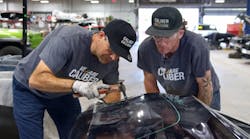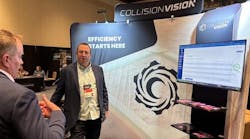Three New Repair Technologies that will Revolutionize Your Shop
Keeping up with the technology offered in the collision repair industry can be tough. So FenderBender went out and did some digging for you. We tapped our sources for some of their favorite repair technology, and here’s what we found: Integrated management systems that work in concert with other shop software are the latest “what’s hot” item on the administrative side of the shop. Smart paint product companies are coming out with new paint accessories that can help drive down cycle time, and our sources tell us why. And for those of you who like to tinker, how about this: a shop tracking system that uses the same technology retailers use to prevent shoplifting.
THE IDEA
To integrate the various software programs shops use, such as management systems, paint systems and customer service indexing systems, so that employees only have to enter data once.
WHEN YOU CAN GET IT
Now. Shops that have a management system should ask their provider what they offer; any shop looking for a management system should make sure they choose one with this capability.
Jeff Smith was sick of watching his front office staff fill out an insurance form for every repair order, fill out the same information again on a file jacket, and then fill it in yet again on an authorization form. So Smith, who works for Bob Thomas CARSTAR in Portland, Ore., invented an integrated management system called FACTS: Forms and Customer Tracking System.
“Now we enter the information into the computer and it generates all the forms needed for every repair order,” or RO, says Smith. “My office staff [saves] 15 to 20 minutes on every RO, so that’s quite a bit of time.”
Two years after inventing this simple time-buster, Smith sold FACTS to CARSTAR. Now, CARSTAR corporate office uses it as a way to track average severity, cycle times, and customer service indexing for each shop. Integration will streamline shops for improvement and help repairers and shop owners focus on increasing productivity and profits, says Jo Pierce, vice president and director of corporate initiatives at CARSTAR. “The goal is to be able to streamline the whole paperwork process for our shops.”
While FACTS is proprietary software, management system companies like Audatex North America Inc., Rome Technologies and Mitchell International Inc.—which has partnered with CARSTAR to integrate FACTS into its management system—now offer systems that integrate with virtually any kind of supporting software to streamline the administrative systems at repair shops.
“It’s an open-architecture structure” of software, says Greg Horn, Mitchell’s vice president of industry relations. “We’re open for new partnerships with anyone, and we’re exploring some now.”
Like Smith’s invention, integration technology is intended to solve a perennial problem in the collision repair industry: having to enter and re-enter information again and again.
“Our solutions currently integrate with a number of these complementary tools, and our plans [are] to deepen our levels of integration in order to help our shop customers achieve even greater improvements in workflow and efficiency,” says Neal Lowell, director of product management for Audatex.
There’s a lot of pressure to focus on being lean in management because there is so much focus on being lean in production, says Smith. “We get burdened with a lot of paperwork and duplicate data entry.” Not, it seems, anymore.
The Latest in Paint Products
THE IDEA
Waterborne paint has been around for a while now, but paint companies and collision repair equipment manufacturers are always coming up with new products and accessories.
WHEN YOU CAN GET IT
Right now
Kristen Felder, CEO of Little Rock, Ark.-based Collision Hub and Collision Hub Consulting, and Darrell Amberson, president of Lehman’s Garage in Bloomington, Minn., shared with us their favorite new spray guns, electric dryers, and compressors. Collision Hub documented through video and interviews the switch of Sterling Autobody Centers’ 63 shops to waterborne last summer, and Lehman’s Garage is starting the process of switching over to waterborne paint in its six Twin Cities Locations. Amberson has been knee-deep in research into the latest waterborne product technology.
THE PRODUCT: composite spray guns with a reusable, detachable head. One pivotal new spray gun technology is composite spray guns with reusable, detachable heads. The atomizing head comes off so you can reuse it or dispose of it after eight to 10 uses. After a shop has primed 10 cars, they can simply take the head off, throw it away, wipe the needle off and take a new head out of the dispenser and you’ve got a new gun on demand.There is less cleaning involved and therefore less corrosion than in typical waterborne paint spray guns because the paint won’t build up, says Felder.
One example of this technology is the 3M Co. Accuspray System. The gun itself is designed to spray primer at lower pressures. A lot of shops use older guns for spraying primer, so they have to crank the pressure up, says Brian Shafer, U.S. marketing manager for 3M. When they do that, they create a lot more overspray. Accuspray enables shops to spray at a lower pressure, 20 PSI at full trigger pull, so they will improve their transfer efficiency and ultimately use less primer. The gun allows the shop to get a smoother, flatter finish, says Shafer. This allows the technician doing the sanding and blocking to spend less time on those tedious tasks.
For more from 3M on its Accuspray System, visit solutions.3m.com or see our interview with Brian Shafer from NACE: bit.ly/NACEVIDEO.
THE PRODUCT: portable electric dryers. The portable blowers use less compressor capacity, and since compressors have limited capacity, the portable dryers are a good solution, says Amberson, who has been researching waterborne products as his six shops started to make the switch to waterborne at the end of 2010. “The alternative is the handheld blowers that you can buy stands for, which work well, but take a lot of compressor capacity.”One product Amberson has been impressed with is the JetDry Express, which functions as an upgrade to SprayZone’s waterborne JetDry system. JetDry Express is a six-foot-tall portable drying system with adjustable nozzles and powered by an electric motor. (For more on JetDry Express, visit SprayZone.net.)
“We have a lot of guys using air tools and spray guns at the same time as guys are using these handheld blowers,” says Amberson. “You’re going to be working the compressor pretty hard and maybe even max out its capacity.”
That won’t be a problem with the portable dryers from JetDry Express.Because they’re electric, they don’t need the compressor to function, says Amberson.
THE PRODUCT: compressors that integrate into a shop’s existing pipe system. Working with water-based paints comes down to airflow, says Felder. “The corner fans really need to give you airflow top to bottom in the booth and a lot of it.” And having electric dryers are a good and new way to get that, she says, but not the only way. A lot of shops’ compressors can’t handle the conversion to waterborne. Shops will make the switch and then not understand why their air pressure and quality is reduced, says Felder. One way to alleviate that problem is to get a compressor that can be integrated into a shop’s existing pipe system, but that doesn’t require the threading or welding that can decrease the amount of air pressure coming down the pipe. Felder likes Kaeser Compressors because they have the aluminum SmartPipe system. Its lack of seams allows for more compression (for more on Kaeser Compressors, visit us.kaeser.com). Even though compressors are expensive, they’re worth it in the long run, Felder says, because having a good compressor can really help your cycle time. “You get enough airflow in a booth, you can flash a panel in like three minutes, and clean air is extremely important.”Radio Frequency Identity (RFID)
THE IDEA
Track a vehicle as it moves through a shop’s repair stations using the same technology retail companies use in the merchandise tags that trigger an alarm when someone takes it out of the store without paying for it.
WHEN YOU CAN GET IT
RFID manufacturers can supply you with tags, software, antennas and training.
When you go shopping, you’ve probably noticed that stores have plastic, beige devices attached to clothes to prevent theft. These are radio frequency identifications (RFIDs) that cause an alarm to go off when they go through the detectors at the store door.
What does that have to do with collision repair? Auto Body Speed Shop (ABSS) in Jacksonville, Fla., will implement RFIDs in the first quarter of 2011 to automatically update the management system and the customer as to the status of the repair, says Derek Naidoo, owner of ABSS. Naidoo’s other shops in South Africa, the U.K. and New Zealand already use RFID systems.
It works like a small-scale global positioning system (GPS), says Naidoo. An antenna is installed in the shop and attached to the server that is constantly scanning the shop and looking for the tags (RFIDs). The tags are attached to each car when it comes into the shop. The shop is mapped on the computer, and when the scanner finds a tag it shows the tag's location in the shop: estimating, disassembly, paint, and so on. Each time the scanner finds a tag, the position is recorded and given an automatic estimate of how long it will be in that location, based on the speed the previous tag took in that location, says Naidoo.
Then the scanner, which is connected to the server, automatically notifies the management system, which notifies the customer the status of their car via email.
“It’s totally automatic, there’s no human intervention,” says Naidoo.
So far RFIDs have worked pretty well for Naidoo’s international locations, says Naidoo. For most shops, this kind of technology might seem more like science fiction—or a large time investment—since it’s not on the market. Naidoo says it’s not hard to rig up a system like this, if you can get your hands on the RFID technology. Two suppliers to try:
• Rfidtags.com: offers products tailored to the automotive industry;
• Rfidsupplychain.com: offers RFID training courses.
Naidoo also emphasizes the importance of integrating such cutting-edge technology with what you already have. “It’s got to tie in with the rest of your shop’s technology. It’s necessity that creates creativity. If there wasn’t a need for it I would’ve just done what everyone else has done.”



